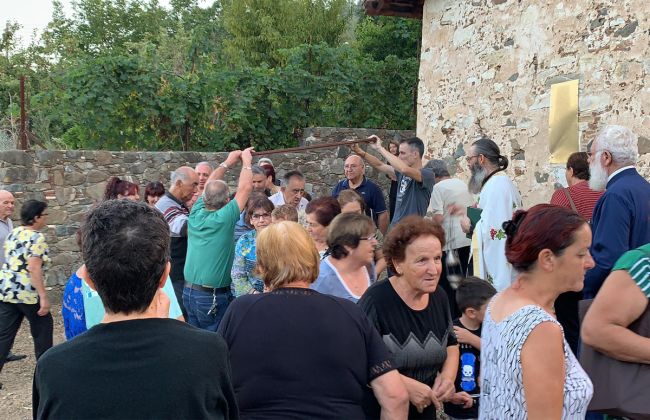Manners & Customs
Manners & Customs of Moniati
The manners and customs of the past still exist today, with the exception of the following, which have been abandoned:
The butchering of the pig
In the past, all independent families raised a pig, which they slaughtered at Christmas to meet their winter meat demands. They prepared sausages, lountza, posirti (so-called smoked ones), and koumniastas, which was meat that was lightly fried and stored in pig fat to be eaten during the winter. This tradition was abandoned because there is a plenty of meat on the market today. In addition, pig breeding in residential areas has been outlawed for health concerns.
Oi sikoses
The sikoses occurred on the two Sundays preceding the Easter fasts. The first Sunday was dedicated to Apokreos, while the second was dedicated to Tyrofagos. On the nights of these two Sundays, close family and friends congregated at a single residence. Each family brought their own food and feasted until the break of dawn. These days, together with the days of Lambras, Christmas, and different social occasions (baptisms, engagements, weddings, festivals, and pilgrimages), were the most enjoyable for the villagers, as they provided relief from their everyday labours.
Lampra’s meal
Unfortunately, this tradition was also abandoned within the last sixty years. This dinner, also known as the feast of love, was held in the churchyard following the conclusion of the Resurrection service. All the families lovingly gathered ancestral flaunas, red eggs, and other foods, and then they had a great time playing traditional games such as the trappedia, the path, the skatoulika, and the ziziros, among others.
The festival of Saitiotissa
This celebration was celebrated on the Friday following Lambra in the courtyard and surrounding fields of the ruined Panagia Zoodochos Pigis church in Saittas. Following the conclusion of the service, all the families in the village and those from adjacent villages engaged in the customary spitting on wooden spits, followed by a feast. Unfortunately, this festival has likewise ceased to occur.




The butchering of the pig
In the past, all independent families raised a pig, which they slaughtered at Christmas to meet their winter meat demands. They prepared sausages, lountza, posirti (so-called smoked ones), and koumniastas, which was meat that was lightly fried and stored in pig fat to be eaten during the winter. This tradition was abandoned because there is a plenty of meat on the market today. In addition, pig breeding in residential areas has been outlawed for health concerns.

Oi sikoses
The sikoses occurred on the two Sundays preceding the Easter fasts. The first Sunday was dedicated to Apokreos, while the second was dedicated to Tyrofagos. On the nights of these two Sundays, close family and friends congregated at a single residence. Each family brought their own food and feasted until the break of dawn. These days, together with the days of Lambras, Christmas, and different social occasions (baptisms, engagements, weddings, festivals, and pilgrimages), were the most enjoyable for the villagers, as they provided relief from their everyday labours.

Lampra’s meal
Unfortunately, this tradition was also abandoned within the last sixty years. This dinner, also known as the feast of love, was held in the churchyard following the conclusion of the Resurrection service. All the families lovingly gathered ancestral flaunas, red eggs, and other foods, and then they had a great time playing traditional games such as the trappedia, the path, the skatoulika, and the ziziros, among others.

The festival of Saitiotissa
This celebration was celebrated on the Friday following Lambra in the courtyard and surrounding fields of the ruined Panagia Zoodochos Pigis church in Saittas. Following the conclusion of the service, all the families in the village and those from adjacent villages engaged in the customary spitting on wooden spits, followed by a feast. Unfortunately, this festival has likewise ceased to occur.
